Scientific name
Zygogramma bicolorata Pallister
Common name
Mexican beetle, Parthenium beetle
Taxonomic position
Coleoptera: Chrysomelidae
Description
Length: width: Body outline elongate and oblong, dorsal surface strongly convex and glabrous. Head black. Ground colour of pronotum and elytra creamy yellow with a pinkish tinge or luteous yellow to buff. Pronotum with a median hat-shaped black marking not covering the lateral and anterolateral
corners. Elytra with the following markings: a stripe adjacent to sutural line, two elongate spots arranged longitudinally, a hook-like elongate marking, and two smaller, posterolateral spots; sutural line with a black stripe, broader in the anterior half. The elytral pattern often shows considerable variation, both within and between populations. Analysis of elytral pattern in Z. bicolorata revealed great variability, with 29 different patterns in 478 beetles. Principal component analysis did not indicate any significant differences between beetles from different localities. Two types of elytral pattern were common. In pattern 1, A1 and A2 bands were made of two and one fragment, respectively (Fig. 1). In pattern 2, both bands were made of one fragment each (Fig. 2). The posterior margin of the last visible abdominal ventrite is whole in the female and slightly serrated at the tip in the male, and the males also had a faint depression at the centre of the last abdominal ventrite (McClay, 1980). Adult males are in general smaller than females.
 Figs. 1-2. Elytral pattern variation in Z. bicolorata Figs. 1-2. Elytral pattern variation in Z. bicolorata
The male genitalia of different populations do not vary much, but the spermathecal pump has been found to show a range of variation. Spermatheca with simple round (Fig. 3) and pointed (Fig. 4) tips are most
common, followed by lobed with pointed (Fig. 5) and round (Fig. 6) tips and branched with round (Fig. 7) and pointed (Fig. 8) tips (Viraktamath et al., 2004).
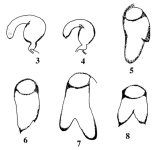 Figs. 3-8. Variation in spermatheca of Z. bicolorata Figs. 3-8. Variation in spermatheca of Z. bicolorataDistribution
Introduced in India in 1984 (Jayanth, 1987); the adult beetles had been distributed to 27 centres in 15 states by 1993. Now well established in southern India. Introduced in Australia.
Host range
In host-specificity tests conducted on 40 plants belonging to 27 families at the time of introduction, slight nibbling was observed on Jasminum grandiflorum and niger (Guizotia abyssinica), but no feeding was observed on sunflower (Jayanth & Nagarkatti, 1987). Feeding by Z. bicolorata on X. strumarium was reported in 1992 (Kumar, 1992) and later, on sunflower in certain pockets of south India in 1993, causing panic and public furore. Detailed field and laboratory studies were carried out to find the reasons for feeding on sunflower and any possible host shift under a collaborative project funded by the Indian Council of Agricultural Research (ICAR). It was found that on both hosts, the developmental duration was longer and the adult longevity shorter. Fecundity and adult survival were also adversely affected (Patel, 2001).
Dusting or treating sunflower leaves with parthenium pollen extract induced Z. bicolorata to feed on sunflower leaves (Jayanth et al., 1993). After complete defoliation of parthenium,
the beetles tended to migrate to nearby sunflower fields attracted by the parthenium pollen deposited on sunflower. Conclusive studies have proved that the beetles do not prefer sunflower, though they initially alight and feed on the leaves. Continuous feeding on sunflower retards normal development of male and female reproductive organs, affecting fecundity.
Biology
Eggs are generally laid on the ventral surface of both young and old leaves, and occasionally on the upper surface of leaves, stems and flowers (Jayanth & Geetha, 1993; Patel, 2001). Eggs are yellow to orange, elongate cylindrical or oblong with fine reticulations on the surface. The eggs hatch in 4-5 days. 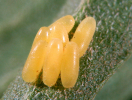
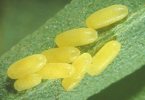 Eggs Eggs
The freshly hatched larvae are pale yellow, turning creamy white as they grow. The larva is fleshy and fusiform or ellipsoidal in outline. The larvae start feeding on the leaf adjacent to the eggs for a short time and then move to the terminal shoots or auxiliary buds. There are four larval instars and the total larval period varies from 10 to 15 days at 28 + 2 oC (Goeden & Ricker, 1979) and from 11 to 13 days at 25.5 +1 oC. The full grown larvae rest without feeding for a few hours to
one day on the undersurface of leaves before burrowing into the soil for pupation (Jayanth & Geetha, 1993). Pupation takes place in a soil chamber formed by the larva 1-3 cm below the soil surface. The pre-pupal stage lasts for a day. The pupal stage lasts from 8.31 days at 25 +1 oC and
12:12 DL regime (Patel, 2001) to 10-12 days (Jayanth & Geetha, 1993).
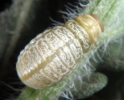
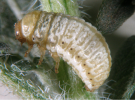
 Full grown larva Full grown larva
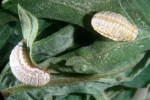
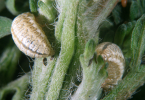
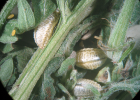 Larvae feeding on parthenium Larvae feeding on parthenium
 Pupa Pupa
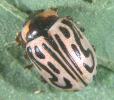
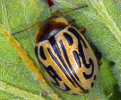

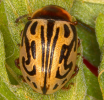 Adult - Dorsal view Adult - Dorsal view
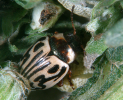
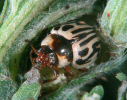
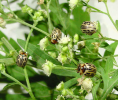 Adults feeding on parthenium Adults feeding on parthenium
Natural enemies
An undetermined species of Palexorista (Diptera: Tachinidae) has been recorded as parasitising Z. bicolorata in Karnataka (Jayanth et al., 1996), which may have an adverse effect on the populations of the beetle reducing its efficacy. Three predatory bugs, Andrallus spinidens (F.), Eocanthecona furcellata (Wolff) (Pentatomidae) and Sycanus pyrrhomelas Walker (Reduviidae), have been known to feed on the grubs, the last feeding on adults also (Gupta et al., 2004).
 Tachinid parasitoid of Z. bicolorata Tachinid parasitoid of Z. bicolorata
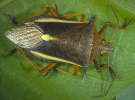 Andrallus spinidens Andrallus spinidensReferences
- Gupta, R.K., Khan, M.S., Bali, K., Monobrullah, M. & Bhagat, R.M. 2004. Predatory bugs of Zygogramma bicolorata Pallister: An exotic beetle for biological suppression of Parthenium hysterophorus L. Current Science, 87(7): 1005-1010.
- Jayanth, K.P. and Geetha, B. 1993. Biological studies on Zygogramma bicolorata Pallister (Coleoptera: Chrysomelidae), a potential biological control agent of Parthenium hysterophorus L. (Asteraceae). Journal of Biological Control, 7(2): 93-98.
- Jayanth, K.P., Mohandas, S., Asokan, R. and Visalakshy, P.N.G. 1993. Parthenium pollen induced feeding by Zygogramma bicolorata (Coleoptera: Chrysomelidae) on sunflower (Helianthus annuus) (Compositae). Bulletin of Entomological Research, 83(4): 595-598.
- Jayanth, K.P., Visalakshy, P.N.G., Ghosh, S.K., & Chaudhary, M. 1996. An indigenous parasitoid on the parthenium beetle, Zygogramma bicolorata. Insect Environment, 2: 67-68.
- Patel, V.N. 2001. Ecological and behavioural studies on the Mexican beetle, Zygogramma bicolorata Pallister (Coleoptera: Chrysomelidae) introduced for the biological control of Parthenium
hysterophorus L. Ph.D. thesis (Unpublished), University of Agricultural Sciences, Bangalore. 142 p.
- Viraktamath, C.A., Bhumannavar, B.S. and Patel, V.N. 2004. Biology and ecology of Zygogramma bicolorata Pallister, 1953, pp. 767-777. In: New Developments in the Biology of Chrysomelidae (Eds. P.
Jolivet, J.A. Santiago-Blay and M. Schmitt). SPB Academic Publishing bv, The Hague, The Netherlands.
|